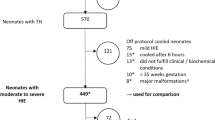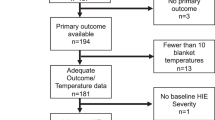Abstract
Objective:
The objective of the study was whether temperature management during therapeutic hypothermia correlates with the severity of brain injury assessed on magnetic resonance imaging in term infants with hypoxic-ischemic encephalopathy.
Study Design:
Prospectively collected register data from the National Asphyxia and Cooling Register of Switzerland were analyzed.
Result:
Fifty-five newborn infants were cooled for 72 h with a target temperature range of 33 to 34 °C. Individual temperature variability (odds ratio (OR) 40.17 (95% confidence interval (CI) 1.37 to 1037.67)) and percentage of temperatures within the target range (OR 0.95 (95% CI 0.90 to 0.98)) were associated with the severity of brain injury seen on magnetic resonance imaging (MRI). Neither the percentage of measured temperatures above (OR 1.08 (95% CI 0.96 to 1.21)) nor below (OR 0.99 (95% CI 0.92 to 1.07) the target range was associated with the severity of brain injury seen on MRI.
Conclusion:
In a national perinatal asphyxia cohort, temperature variability and percentage of temperatures within the target temperature range were associated with the severity of brain injury.
This is a preview of subscription content, access via your institution
Access options
Subscribe to this journal
Receive 12 print issues and online access
$259.00 per year
only $21.58 per issue
Buy this article
- Purchase on Springer Link
- Instant access to full article PDF
Prices may be subject to local taxes which are calculated during checkout




Similar content being viewed by others
References
Jacobs SE, Berg M, Hunt R, Tarnow-Mordi WO, Inder TE, Davis PG . Cooling for newborns with hypoxic ischaemic encephalopathy. Cochrane Database Syst Rev 2013; 1: CD003311.
Shankaran S, Laptook AR, Tyson JE, Ehrenkranz RA, Bann CM, Das A et al. Evolution of encephalopathy during whole body hypothermia for neonatal hypoxic-ischemic encephalopathy. J Pediatr 2012; 160 (4): 567–72.e3.
Azzopardi D, Strohm B, Marlow N, Brocklehurst P, Deierl A, Eddama O et al. Effects of hypothermia for perinatal asphyxia on childhood outcomes. N Engl J Med 2014; 371 (2): 140–149.
Shankaran S, Pappas A, McDonald SA, Vohr BR, Hintz SR, Yolton K et al. Childhood outcomes after hypothermia for neonatal encephalopathy. N Engl J Med 2012; 366 (22): 2085–2092.
Shankaran S, Laptook AR, McDonald SA, Higgins RD, Tyson JE, Ehrenkranz RA et al. Temperature profile and outcomes of neonates undergoing whole body hypothermia for neonatal hypoxic-ischemic encephalopathy. Pediatr Crit Care Med 2012; 13 (1): 53–59.
Shankaran S, Laptook AR, Pappas A, McDonald SA, Das A, Tyson JE et al. Effect of depth and duration of cooling on deaths in the NICU among neonates with hypoxic ischemic encephalopathy: a randomized clinical trial. JAMA 2014; 312 (24): 2629–2639.
Thoresen M . Cooling after perinatal asphyxia. Semin Fetal Neonatal Med 2015; 20 (2): 65.
Nielsen N, Wetterslev J, Cronberg T, Erlinge D, Gasche Y, Hassager C et al. Targeted temperature management at 33 degrees C versus 36 degrees C after cardiac arrest. N Engl J Med 2013; 369 (23): 2197–2206.
Zeiner A, Holzer M, Sterz F, Schorkhuber W, Eisenburger P, Havel C et al. Hyperthermia after cardiac arrest is associated with an unfavorable neurologic outcome. Arch Intern Med 2001; 161 (16): 2007–2012.
Laptook A, Tyson J, Shankaran S, McDonald S, Ehrenkranz R, Fanaroff A et al. Elevated temperature after hypoxic-ischemic encephalopathy: risk factor for adverse outcomes. Pediatrics 2008; 122 (3): 491–499.
Laptook AR, McDonald SA, Shankaran S, Stephens BE, Vohr BR, Guillet R et al. Elevated temperature and 6- to 7-year outcome of neonatal encephalopathy. Ann Neurol 2013; 73 (4): 520–528.
Brotschi B, Grass B, Ramos G, Beck I, Held U, Hagmann C et al. The impact of a register on the management of neonatal cooling in Switzerland. Early Hum Dev 2015; 91 (4): 277–284.
Sarnat HB, Sarnat MS . Neonatal encephalopathy following fetal distress. A clinical and electroencephalographic study. Arch Neurol 1976; 33 (10): 696–705.
Barkovich AJ, Hajnal BL, Vigneron D, Sola A, Partridge JC, Allen F et al. Prediction of neuromotor outcome in perinatal asphyxia: evaluation of MR scoring systems. AJNR Am J Neuroradiol 1998; 19 (1): 143–149.
Rutherford MA, Pennock JM, Counsell SJ, Mercuri E, Cowan FM, Dubowitz LM et al. Abnormal magnetic resonance signal in the internal capsule predicts poor neurodevelopmental outcome in infants with hypoxic-ischemic encephalopathy. Pediatrics 1998; 102 (2 Pt 1): 323–328.
Busto R, Dietrich WD, Globus MY, Valdes I, Scheinberg P, Ginsberg MD . Small differences in intraischemic brain temperature critically determine the extent of ischemic neuronal injury. J Cereb Blood Flow Metab 1987; 7 (6): 729–738.
Wood T, Osredkar D, Puchades M, Maes E, Falck M, Flatebo T et al. Treatment temperature and insult severity influence the neuroprotective effects of therapeutic hypothermia. Sci Rep 2016; 6: 23430.
Sarkar S, Donn SM, Bapuraj JR, Bhagat I, Barks JD . Distribution and severity of hypoxic-ischaemic lesions on brain MRI following therapeutic cooling: selective head versus whole body cooling. Arch Dis Child Fetal Neonatal Ed 2012; 97 (5): F335–F339.
Tagin MA, Woolcott CG, Vincer MJ, Whyte RK, Stinson DA . Hypothermia for neonatal hypoxic ischemic encephalopathy: an updated systematic review and meta-analysis. Arch Pediatr Adolesc Med 2012; 166 (6): 558–566.
Acknowledgements
We would like to thank Professor Frances Cowan for carefully reviewing this manuscript for its scientific content. The National Asphyxia and Cooling Register group: Aarau: Cantonal Hospital Aarau, Children's Clinic, Department of Neonatology (Th. Voelcker, Ph. Meyer); Basel: University Children's Hospital Basel (UKBB), Department of Neonatology (SM Schulzke, S Wellmann); Berne: University Hospital Berne, Department of Pediatric Intensive care (B Wagner, K Daetwyler); Chur: Children's Hospital Chur, Department of Neonatology (W Bär, B Scharrer); Lausanne: University Hospital (CHUV), Department of Neonatology (J-F Tolsa, A Truttmann, J Schneider); Geneva: University Hospital (HUG), Division of Neonatology (RE Pfister); Lucerne: Children's Hospital of Lucerne, Neonatal and Pediatric Intensive Care Unit (TM Berger, M Fontana); St Gallen: Children's Hospital St Gallen, Neonatal and Pediatric Intensive Care Unit (JP Micallef, I Hoigné); Zurich: University Hospital Zurich (3), Department of Neonatology (D Bassler, G Natalucci, M Adams); and University Children's Hospital Zurich, Department of Intensive Care and Neonatology (B Frey, V Bernet). BB was supported by a grant of the ‘Filling the Gap’ Program at the University of Zurich, Switzerland.
Author information
Authors and Affiliations
Consortia
Corresponding author
Ethics declarations
Competing interests
The authors declare no conflict of interest.
Rights and permissions
About this article
Cite this article
Brotschi, B., Gunny, R., Rethmann, C. et al. Relationship between temperature variability and brain injury on magnetic resonance imaging in cooled newborn infants after perinatal asphyxia. J Perinatol 37, 1032–1037 (2017). https://doi.org/10.1038/jp.2017.96
Received:
Revised:
Accepted:
Published:
Issue Date:
DOI: https://doi.org/10.1038/jp.2017.96
This article is cited by
-
Clonidine for sedation in infants during therapeutic hypothermia with neonatal encephalopathy: pilot study
Journal of Perinatology (2022)



